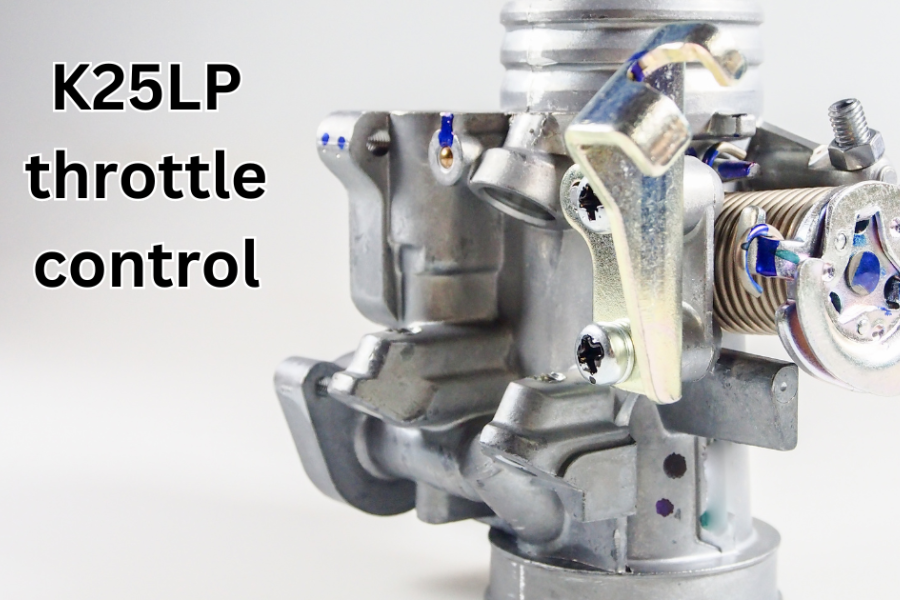K25LP: A Comprehensive Look at Throttle Control Technology
The K25LP throttle control system marks a noteworthy step forward in automotive technology, offering precise management of engine throttle response. This system plays a crucial role in optimizing vehicle performance by regulating the air-fuel mixture that enters the engine, ultimately enhancing efficiency, responsiveness, and the overall driving experience. Engineered for versatility, the K25LP is suitable for a variety of vehicles, including sedans, SUVs, and performance cars. Unlike traditional systems that rely on mechanical cables, the K25LP utilizes electronic sensors and actuators for more accurate adjustments in response to real-time driving conditions. This shift from mechanical to electronic control has transformed driver interaction with their vehicles, resulting in a smoother and more intuitive driving experience.
The Significance of Throttle Control in Modern Vehicles
Throttle control is essential in today’s vehicles, as it directly affects engine efficiency and performance. An effective throttle system not only boosts engine power but also contributes to better fuel economy and reduced emissions. With the growing focus on environmental sustainability, both automakers and consumers prioritize systems that optimize these aspects. The K25LP throttle control system, with its advanced technology, ensures that the engine responds quickly and accurately to the driver’s commands, enhancing the overall driving experience. As consumer demands for performance and efficiency continue to rise, sophisticated throttle control systems like the K25LP are becoming increasingly vital.
Overview of the K25LP Model and Its Applications
Designed for adaptability across different automotive applications, the K25LP throttle control system enhances throttle response and engine management in everything from everyday commuter vehicles to high-performance sports cars. Its precise operation is particularly valued in environments where responsiveness is key, such as racing, off-roading, and heavy-duty towing. Focused on reliability and performance, the K25LP has attracted attention from both manufacturers and consumers aiming to upgrade their vehicles’ capabilities. Its compatibility with a wide range of engines and driving scenarios makes it an ideal choice for automotive enthusiasts seeking to improve their driving experience.
Understanding Throttle Control Systems
What is Throttle Control?
Throttle control refers to the system that manages the flow of air into the engine, thereby influencing its power output. This regulation is crucial for optimizing performance and fuel efficiency. Traditionally, throttle systems used mechanical linkages connecting the accelerator pedal directly to the throttle body. However, advancements in technology have led to the widespread adoption of electronic throttle control (ETC) systems. These systems employ sensors and electronic controls to adjust the throttle position based on driver input, engine load, and other variables, resulting in a more fluid and responsive driving experience.
Types of Throttle Control Systems
Throttle control systems can be categorized into two main types: mechanical and electronic. Mechanical throttle systems utilize a physical cable linked to the accelerator pedal, providing a direct connection between the driver’s input and throttle response. While this setup is simple and reliable, it may lack the precision and responsiveness of electronic systems. In contrast, electronic throttle control systems like the K25LP employ sensors to monitor pedal position and relay signals to the engine control unit (ECU), which then adjusts the throttle position accordingly. This electronic approach offers numerous benefits, including enhanced fuel efficiency, improved performance, and the ability to integrate with advanced vehicle safety features.
Enhancing Vehicle Performance with Throttle Control Systems
Throttle control systems significantly enhance overall vehicle performance by optimizing the delivery of engine power. In modern vehicles, precise throttle control enables smoother acceleration, improved handling, and better fuel economy. By adapting throttle response to current driving conditions, electronic systems create a more dynamic driving experience. For example, during rapid acceleration, the system can open the throttle more quickly to increase power output. Conversely, in scenarios that require gentler acceleration—such as on slippery surfaces—the system can modulate throttle response to prevent wheel spin. This adaptability is crucial for balancing performance and safety across various driving conditions.
Features of the K25LP Throttle Control
Key Specifications of the K25LP
The K25LP throttle control system is equipped with a range of key specifications that significantly enhance its performance and usability. One of its standout features is its high-speed processing capability, enabling it to adjust throttle positions in mere milliseconds. This rapid response is vital for optimizing engine performance under diverse driving conditions. The system incorporates advanced sensors that continuously monitor critical parameters such as engine load, speed, and temperature, ensuring that throttle positions are adjusted accurately and in real time. Furthermore, the K25LP boasts a robust construction designed to endure extreme conditions, making it suitable for both everyday driving and high-performance applications.
Technical Capabilities and Limitations
While the K25LP throttle control system offers a host of technical advantages, it is important for users to be aware of its limitations. A notable strength of the K25LP is its ability to integrate seamlessly with vehicle stability control and anti-lock braking systems, thereby enhancing overall safety. This integration enables the K25LP to modulate throttle response in scenarios where traction control is active, improving vehicle handling and stability. However, like any electronic system, the K25LP may face issues related to sensor malfunctions or electrical faults, which can impact performance. Regular maintenance and diagnostics are crucial for ensuring the system operates at peak efficiency, allowing drivers to maximize its advanced features.
Advantages Over Competing Throttle Control Models
The K25LP throttle control system offers several benefits compared to other models, particularly in terms of performance and versatility. Its electronic design facilitates smoother acceleration and deceleration compared to traditional mechanical systems, enhancing the overall driving experience. Moreover, drivers can customize throttle response settings to match their preferences, whether they seek a sportier feel or a more relaxed driving style. Additionally, the K25LP’s compatibility with a wide variety of vehicles makes it a versatile choice for both aftermarket upgrades and original equipment manufacturer (OEM) applications. These advantages establish the K25LP as a top choice for those looking to elevate their vehicle’s performance and responsiveness.
How the K25LP Throttle Control Functions
Basic Principles of Throttle Control
The K25LP throttle control system is based on the fundamental principle of managing the air intake to the engine in accordance with driver inputs. When the driver presses the accelerator pedal, sensors detect this action and transmit the information to the engine control unit (ECU). The ECU then calculates the optimal throttle position necessary to achieve the desired engine power output. This electronic communication allows the engine to respond quickly and accurately, resulting in a more seamless driving experience. Additionally, the K25LP is designed to adapt to various driving conditions, fine-tuning throttle response to optimize performance, efficiency, and safety.
The Role of Sensors in K25LP Throttle Control
Sensors are vital components of the K25LP throttle control system, providing real-time data essential for throttle adjustments. The primary sensor is the accelerator pedal position sensor, which detects the angle of the pedal and relays this information to the ECU. Other sensors, such as the throttle position sensor and mass airflow sensor, collaborate to monitor engine conditions and adjust the throttle position accordingly. By continuously analyzing data from these sensors, the K25LP can make precise adjustments, ensuring optimal engine performance. This sensor-driven approach contributes to improved fuel efficiency, reduced emissions, and enhanced overall driving dynamics.
Step-by-Step Operation of the K25LP System
The operation of the K25LP throttle control system can be outlined in several key steps. First, when the driver presses the accelerator pedal, the accelerator pedal position sensor detects this movement and sends a signal to the ECU. Next, the ECU processes this signal alongside data from other sensors, including the throttle position and engine load sensors. Based on this comprehensive information, the ECU determines the optimal throttle position needed to deliver the desired power output. The electronic throttle actuator then adjusts the throttle plate accordingly, allowing more or less air to enter the engine. This entire process occurs in real time, ensuring that the engine responds swiftly and accurately to driver inputs, ultimately enhancing the driving experience.
K25LP Throttle Control Installation Guide
Preparation for Installation
Before you begin installing the K25LP throttle control system, proper preparation is key to ensuring a smooth and efficient process. Start by collecting all the necessary tools and equipment, including a socket set, screwdrivers, wiring harnesses, and any vehicle-specific specialized tools. It’s also a good idea to consult your vehicle’s service manual to familiarize yourself with any specific installation requirements or steps. Don’t forget to disconnect the vehicle’s battery to avoid electrical shocks and ensure safety throughout the installation. Lastly, choose a well-lit and spacious area that allows easy access to the vehicle’s components.
Tools Needed for Installation
To successfully install the K25LP throttle control system, you will need various tools to ensure a proper fit and secure connections. Essential tools include:
- Socket set: For removing and securing different components.
- Screwdrivers: For fastening the throttle body and sensors.
- Pliers: For managing wiring connections.
- Torque wrench: To tighten bolts to manufacturer specifications, if necessary.
- Wire strippers and crimping tools: Helpful for preparing and securing wiring connections.
Having the appropriate tools on hand will streamline the installation process and help avoid potential issues later.
Step-by-Step Installation Instructions
- Disconnect the Battery: Begin by disconnecting the negative terminal of the battery to eliminate the risk of electrical shock during installation.
- Remove the Old Throttle Control: Locate the existing throttle control unit, carefully disconnect any electrical connectors and cables, and use the socket set to remove any securing bolts. Gently lift the old unit out.
- Install the K25LP Throttle Control: Position the K25LP throttle control in place and secure it using the provided bolts. Ensure all mounting points align properly.
- Connect the Wiring Harness: Carefully connect the wiring harness to the K25LP throttle control, ensuring a snug fit. Follow the manufacturer’s instructions for connecting any additional sensors.
- Reconnect the Battery: Once all components are securely installed and connected, reconnect the negative terminal of the battery.
- Test the System: Start the vehicle and test the throttle response. Ensure the K25LP throttle control operates smoothly and that no warning lights are illuminated on the dashboard. Adjust settings as needed for optimal performance.
Maintenance Tips for K25LP Throttle Control
Regular Inspection and Cleaning
To maintain the longevity and optimal performance of the K25LP throttle control system, it’s important to conduct regular inspections and cleaning. Begin by visually checking the throttle body for any dirt, debris, or carbon buildup that could affect throttle response. If you spot any contaminants, clean the throttle body carefully with a suitable cleaner and a soft cloth. Additionally, inspect the wiring connections for any signs of wear or damage, as these issues can lead to performance setbacks. Routine maintenance helps prevent costly repairs and ensures efficient system operation.
Common Issues and Troubleshooting Tips
Even though the K25LP throttle control system is generally reliable, it may face common problems that require troubleshooting. A typical issue is poor throttle response, which can stem from a dirty throttle body or malfunctioning sensors. If you experience sluggish acceleration, clean the throttle body and check the sensor connections for any loose wires. Another potential concern is warning lights illuminating on the dashboard, signaling a possible malfunction in the throttle control system. Using a diagnostic scanner can help pinpoint specific error codes, guiding further troubleshooting efforts. Addressing these common issues promptly can enhance system performance and longevity.
When to Seek Professional Help
While many maintenance tasks can be managed by vehicle owners, there are times when it’s wise to seek professional assistance. If you encounter complex issues, such as persistent warning lights, unusual noises during operation, or a significant decline in performance, it may be time to consult a qualified mechanic. Professionals have access to specialized diagnostic tools and expertise to accurately identify underlying problems. Additionally, if you are not familiar with electrical systems or lack the necessary tools for repairs, enlisting professional help can prevent potential errors and ensure your K25LP throttle control system operates optimally.
Benefits of Using K25LP Throttle Control
Enhanced Fuel Efficiency
A key advantage of the K25LP throttle control system is its ability to improve fuel efficiency. By accurately regulating the airflow into the engine, the K25LP allows the engine to perform at its most efficient level, regardless of driving conditions. This optimized efficiency leads to better fuel mileage, making it especially beneficial for drivers who want to reduce fuel expenses. Thanks to its electronic design, the K25LP can make precise adjustments that traditional mechanical systems cannot, resulting in a more optimal air-fuel mixture. This not only maximizes fuel utilization but also minimizes waste, contributing to overall savings at the pump.
Improved Driving Experience
The K25LP throttle control system enhances the driving experience by enabling smooth acceleration and deceleration. Drivers benefit from a more responsive and engaging ride, as the system quickly reacts to accelerator pedal inputs. This responsiveness is particularly advantageous during overtaking, where quick throttle response is crucial for safe and efficient driving. Additionally, the ability to customize throttle response settings means drivers can tailor the system to match their driving preferences—whether they desire a sportier, more dynamic experience or a more laid-back, comfortable ride. Ultimately, the K25LP strengthens the connection between the driver and the vehicle, making every trip more enjoyable.
Increased Vehicle Longevity
By optimizing engine performance and efficiency, the K25LP throttle control system can contribute to the longevity of your vehicle. Efficient engine operation reduces wear on internal components, which can lead to fewer mechanical problems over time. The system’s capability to adapt to various driving conditions helps alleviate excessive strain on the engine, promoting durability. Moreover, regular maintenance and inspections of the K25LP system can help identify potential issues before they escalate, allowing for timely repairs and ensuring that your vehicle remains in top condition for years to come.
Compatibility of K25LP Throttle Control with Different Vehicles
Vehicle Models that Support K25LP
The K25LP throttle control system is designed for broad compatibility, making it an excellent choice for drivers seeking to upgrade their throttle systems. It can enhance performance across a wide array of vehicle models, from compact cars to larger SUVs. Its adaptability allows for seamless integration with many OEM engine management systems, ensuring optimal performance regardless of the vehicle’s make or model. This versatility makes the K25LP a great option for both aftermarket installations and new vehicle builds.
Factors Affecting Compatibility
While the K25LP throttle control system works with many vehicles, several factors can influence its compatibility for specific applications. One important consideration is the type of engine in the vehicle, as different engines may have unique throttle control needs. Additionally, the existing electrical systems in the vehicle must be compatible with the K25LP to ensure proper communication between components. Modifications made to the vehicle, such as engine or exhaust changes, can also impact compatibility. Before purchasing the K25LP, it’s wise to consult the manufacturer’s guidelines or seek professional advice to confirm a proper fit.
How to Check Compatibility with Your Vehicle
To verify whether the K25LP throttle control system is compatible with your vehicle, start by reviewing the manufacturer’s specifications and installation guidelines. Most manufacturers provide detailed information on compatible models and any necessary modifications. Online forums or automotive enthusiast communities can also be great resources for insights and experiences regarding compatibility. If you have any doubts, consider consulting a professional mechanic or automotive specialist who can assess your vehicle’s specific requirements and recommend the best throttle control options to meet your needs.
Troubleshooting K25LP Throttle Control Issues
Common Problems with K25LP Throttle Control
Like many electronic systems, the K25LP throttle control can encounter various issues that affect its performance. One common problem is a lack of responsiveness, where the throttle does not respond promptly to driver inputs. This can be caused by dirty sensors or debris buildup in the throttle body, which restricts airflow. Additionally, electrical issues such as loose connections or damaged wiring can disrupt the system’s functionality, resulting in erratic behavior or complete failure. Detecting these issues early is crucial to prevent more serious problems later on.
Diagnostic Tips for Effective Troubleshooting
To effectively troubleshoot issues with the K25LP throttle control, begin with a visual inspection of the throttle body and the associated wiring. Check for signs of wear, corrosion, or any loose connections that could impair performance. Using an OBD-II scanner can also provide valuable diagnostic information by revealing error codes related to the throttle control system. Pay particular attention to codes indicating sensor malfunctions or communication problems with the engine control unit (ECU). After identifying the issue, cleaning the throttle body and ensuring all electrical connections are secure can often resolve many common problems. If difficulties persist, consulting a professional mechanic may be necessary for more comprehensive diagnostics.
How to Fix or Replace Faulty Components
If troubleshooting identifies faulty components in the K25LP throttle control system, it’s important to address these issues quickly to restore optimal performance. For minor problems, such as dirty sensors or a clogged throttle body, a thorough cleaning may be sufficient. Utilize a throttle body cleaner and a soft cloth to eliminate any contaminants, ensuring the throttle plate can move freely. However, if you discover more significant damage, like a malfunctioning throttle position sensor or damaged wiring, a replacement may be required. Always opt for high-quality parts when replacing components to preserve system integrity. After completing any repairs or replacements, it’s a good idea to reset the ECU to recalibrate the throttle control system and ensure everything operates as it should.
K25LP Throttle Control vs. Other Throttle Controllers
Comparative Analysis with Other Models
When evaluating the K25LP throttle control system against other throttle controllers available on the market, several key factors must be considered, including responsiveness, adaptability, and installation ease. Traditional mechanical throttle systems may boast simplicity, but they often fall short in precision and adjustability compared to electronic systems like the K25LP. While there are various electronic throttle controllers, not all offer the same level of integration with vehicle safety systems or the customization features that the K25LP provides. This comparison emphasizes the K25LP’s distinct advantages, particularly for those drivers who prioritize enhanced performance and efficiency.
Performance Metrics: K25LP vs. Competitors
Performance metrics are essential when assessing the K25LP throttle control system in relation to its competitors. Important metrics to consider include throttle response time, improvements in fuel efficiency, and adaptability to different driving conditions. The K25LP’s rapid response time ensures that the engine quickly reacts to driver inputs, which is crucial for performance-driven applications. Additionally, the system’s ability to optimize fuel efficiency results in significant savings for drivers. When comparing these metrics with those of competing models, it becomes clear that the K25LP is a standout choice for anyone seeking a high-performance throttle control solution.
User Reviews and Experiences
User reviews offer valuable insights into the real-world performance of the K25LP throttle control system compared to other options. Many users report noticeable enhancements in throttle response and overall driving dynamics after installing the K25LP. Positive feedback often emphasizes the system’s adaptability across various driving scenarios, whether for daily commutes or spirited drives on twisty roads. While some competitors also receive favorable remarks, the K25LP consistently earns praise for its seamless integration with existing vehicle systems and its capacity to elevate the driving experience. Prospective buyers can benefit from reading user testimonials to make informed choices regarding throttle control systems.
Future Trends in Throttle Control Technology
Emerging Technologies in Throttle Control
As automotive technology advances, the future of throttle control systems like the K25LP looks promising. Innovations such as artificial intelligence (AI) and machine learning are expected to transform how these systems function. These developments could enable throttle control systems to learn and adjust according to individual driving styles, optimizing performance to suit user preferences. Furthermore, advancements in sensor technology are likely to improve the accuracy and responsiveness of throttle control systems, facilitating even more precise engine performance adjustments.
Integration with Autonomous Driving Systems
The integration of throttle control systems with autonomous driving technologies represents another significant trend in the evolution of automotive engineering. As vehicles move toward higher levels of automation, throttle control systems will play a pivotal role in ensuring smooth and responsive operation. Advanced algorithms will be created to manage throttle response in conjunction with other vehicle systems, such as steering and braking, to create a seamless driving experience. This integration is vital for the safety and efficiency of autonomous vehicles, as real-time adjustments will be necessary to navigate complex driving scenarios.
Impact of Environmental Regulations on Throttle Control Design
With environmental regulations becoming more stringent, throttle control systems must adapt in both design and functionality. Manufacturers will face pressure to create systems that not only enhance performance but also reduce emissions and improve fuel efficiency. This shift will drive innovation within throttle control technology, leading to the development of more sophisticated systems capable of optimizing engine performance while minimizing environmental impact. Consequently, products like the K25LP are likely to evolve to meet these demands, incorporating features that align with the automotive industry’s sustainability goals.
Case Studies of K25LP Throttle Control Implementation
Success Stories from Automotive Enthusiasts
Numerous automotive enthusiasts have shared positive experiences after implementing the K25LP throttle control system in their vehicles. For example, a performance-focused sedan owner noted a remarkable improvement in throttle response, enabling quicker acceleration during track events. The driver highlighted how the K25LP’s adaptability allowed for the customization of throttle settings based on driving conditions, enhancing both performance and enjoyment on the racetrack. Likewise, SUV owners have commended the system for boosting towing capabilities and overall power delivery, showcasing the K25LP’s versatility across various applications.
Real-World Applications in Racing
In the competitive racing arena, the K25LP throttle control system has earned recognition for its ability to enhance performance on the track. Racing teams have adopted this system to optimize engine response, allowing drivers to make precise adjustments during high-speed maneuvers. The K25LP’s rapid throttle response has proven advantageous in competitive settings, where milliseconds can make all the difference in race outcomes. Drivers have reported improved handling and better power management, resulting in faster lap times and increased competitiveness.
Feedback from Automotive Professionals
Automotive professionals, including mechanics and engineers, reinforce the K25LP’s reputation for reliability and performance. Many appreciate the system’s straightforward installation and compatibility with various vehicle types. They often highlight the K25LP’s seamless integration with existing engine management systems, enabling easy upgrades without extensive modifications. The positive feedback from industry experts further solidifies the K25LP’s status as a premier choice for throttle control solutions.
Conclusion
In conclusion, the K25LP throttle control system represents a significant leap in automotive technology, delivering numerous benefits for drivers seeking enhanced performance and efficiency. Its electronic design ensures precise throttle response, leading to improved fuel efficiency and a more engaging driving experience. Furthermore, its compatibility with a wide range of vehicle models makes it an attractive option for both aftermarket installations and OEM applications. The K25LP’s ability to adapt to various driving conditions guarantees optimal performance across different scenarios.
As the automotive industry progresses, throttle control systems like the K25LP will be pivotal in shaping the future of vehicle performance. With emerging technologies and growing demands for sustainability, the K25LP is well-positioned to evolve and thrive in this dynamic landscape. By focusing on precision, responsiveness, and compatibility, the K25LP sets a standard for throttle control solutions, ensuring that drivers enjoy a seamless and satisfying driving experience for years to come. Whether for performance enthusiasts or everyday drivers, the K25LP throttle control system exemplifies the ongoing advancements in automotive engineering.
Facts
- Technology Advancement: The K25LP throttle control system uses electronic sensors and actuators for precise engine throttle management, enhancing performance over traditional mechanical systems.
- Vehicle Compatibility: This system is designed to be compatible with a wide range of vehicles, including sedans, SUVs, and performance cars, and integrates seamlessly with various OEM engine management systems.
- Customizable Experience: Drivers can customize throttle response settings to suit their driving preferences, allowing for either sporty performance or a more comfortable ride.
- Increased Longevity: By optimizing engine efficiency, the K25LP can reduce wear on internal components, promoting the longevity and durability of the vehicle.
- Troubleshooting Capabilities: Common issues include lack of responsiveness due to dirty sensors or electrical problems. Visual inspections and OBD-II scanners are recommended for diagnostics.
- Future Trends: Emerging technologies, such as AI and machine learning, are expected to further enhance throttle control systems like the K25LP by optimizing performance based on driving styles.
FAQs
1. What is the K25LP throttle control system?
The K25LP throttle control system is an electronic throttle management solution that enhances vehicle performance by accurately regulating engine throttle response and optimizing air-fuel mixture delivery.
2. Which vehicles are compatible with the K25LP throttle control?
The K25LP is compatible with a broad range of vehicles, including compact cars, sedans, SUVs, and performance cars. It integrates well with various OEM engine management systems.
3. How does the K25LP improve driving experience?
The K25LP offers customizable throttle response settings, allowing drivers to adjust the system for a sportier or more comfortable ride, enhancing overall driving enjoyment and responsiveness, especially during overtaking.
4. What should I do if my K25LP throttle control system is not responsive?
If you experience a lack of responsiveness, start with a visual inspection of the throttle body and wiring. Cleaning the throttle body and ensuring secure electrical connections can often resolve issues. An OBD-II scanner can help diagnose specific problems.
5. Can the K25LP throttle control system affect vehicle longevity?
Yes, by optimizing engine performance and reducing wear on components, the K25LP can contribute to the longevity and durability of your vehicle over time.
6. What future technologies could enhance throttle control systems like the K25LP?
Future advancements may include artificial intelligence and machine learning, enabling throttle control systems to adapt to individual driving styles and preferences for even greater performance optimization.





